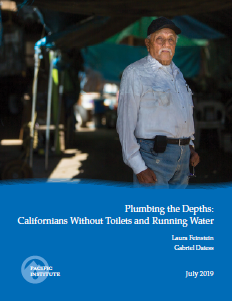Plumbing the Depths: Californians Without Toilets and Running Water

Plumbing the Depths: Californians Without Toilets and Running Water
Overview
California’s Human Right to Water law states that “every human being has the right to safe, clean, affordable, and accessible water adequate for human consumption, cooking, and sanitary purposes.” But to date, the policy discussion on meeting California’s Human Right to Water has largely overlooked the failures of water and sanitation service that emerge because of a lack of household plumbing.
This report fills that gap by measuring the number of Californians without toilets and hot and cold running water because of incomplete household plumbing and homelessness. To achieve full realization of the Human Right to Water in California, the authors propose that the state address the problem of inadequate plumbing within California’s larger policy framework of the Human Right to Water.
Key Findings
Key findings of the report include:
In 2015, 208,000 Californians had inadequate access to toilets. 88,000 people lived in a household without a private indoor flush toilet. Another 120,000 people experiencing homelessness were also unlikely to have adequate access to a toilet.
In 2015, 211,000 Californians had inadequate access to hot and cold running water. 91,000 people lived in a household without hot and cold running water. Another 120,000 people experiencing homelessness were also unlikely to have adequate access to hot and cold running water.
Incomplete plumbing was a problem throughout the state, in both urban and rural areas. Counties with the highest rates of housing without toilets were San Francisco (2.3 percent), Humboldt (0.89 percent), and Imperial (0.60 percent), while counties with the highest rates of housing without hot and cold indoor piped water were Shasta (0.96 percent), Imperial (0.73 percent), and San Francisco (0.71 percent).
Many Californians live in buildings with shared bathrooms, which are often poorly maintained. Housing units with incomplete plumbing were concentrated in low-income urban areas with high numbers of Single-Room Occupancies. Public health agencies have often found shared toilets to be unclean or in disrepair.
Many single-family homes also lacked a private toilet or indoor running water. There were 17,000 stand-alone structures (single-family homes, mobile homes, and temporary shelters) that lacked an indoor flush toilet. These households did not have access to shared facilities in the building.
Most households with incomplete plumbing lacked a toilet, shower, or both. The majority (86 percent) of those with incomplete plumbing lacked either a toilet, hot and cold water, or both. The remaining 14 percent lacked only a tub or shower.
Income and race correlated with incomplete plumbing by census tract. Median household income was the strongest predictor of rates of incomplete plumbing. Racial makeup was also statistically significant.
Resources
Appendix I: Data on Plumbing in California (.xlsx spreadsheet)
Water and Sanitation in California (PowerPoint presentation)

